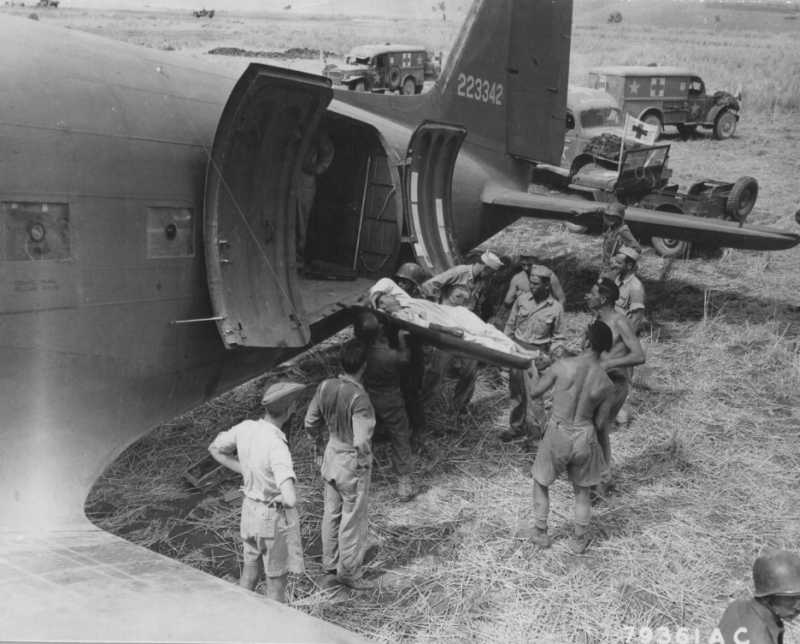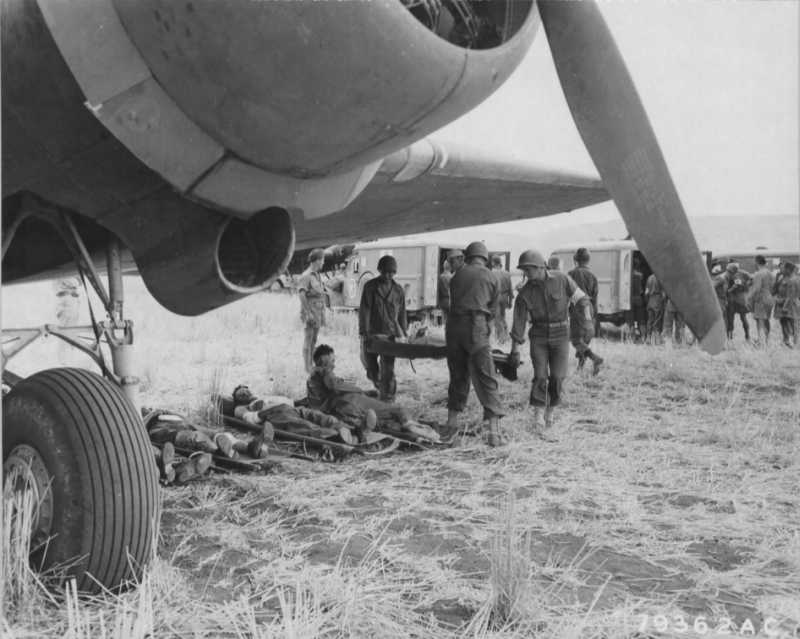Air Operations, Aleutians
40 343rd Fighter Group P-40s and Canadian Kittyhawks mount 7 separate attacks against Kiska.
[Air Operations, CBI
CHINA- Japanese bombers based at Canton and Hankow continue to mount heavy attacks against 14th Air Force bases in eastern China.
- 23rd Fighter Group P-40s down 4 A6M Zeros over Kweilin and Hengyang between 1500 and 1545 hours.
- In response to bombing attacking against 14th Air Force bases in eastern China, 9 11th Medium Bomb Squadron B-25s, escorted by 17 23rd Fighter Group P-40s and 449th Fighter Squadron P-38s, attack the airfield at Hankow, where many of the Japanese bombers are based. This is the first offensive mission undertaken in the theater by P-38s.
Air Operations, East Indies
380th Heavy Bomb Group B-24s mount individual attacks against targets in the Molucca Islands.
[Air Operations, Europe
RAF BOMBER COMMANDEvening Ops:
- 705 aircraft are sent to Essen. In this total are 294 Lancasters, 221 Halifaxes, 104 Stirlings, 67 Wellingtons and 19 Mosquitos.
- This is an attempt to make a good raid on this major target while the effects of 'Window' are still fresh. The raid is a success with significant damage in Essen's industrial areas in the eastern half of the city. The Krupps works suffers probably its most damaging raid of the war. The next morning, Dr Gustav Krupp suffered a stroke from which he never recovered and probably saved him from being charged with war crimes after the war. Fierce fires are started in the city. The damage inflicted on the city prompts Goebbels to write in his diary, 'The last raid on Essen caused a complete stoppage of production in the Krupp works. Speer is much concerned and worried.' A total of 340 Germans are killed.
- 10 Halifaxes, 7 Stirlings, 5 Lancasters and 4 Wellingtons are lost.
- 6 Mosquitos are sent to Hamburg, and 3 each to Cologne and Gelsenkirchen. 17 aircraft lay mines in the Frisians and there are 7 OTU sorties.
- There are no losses.
BELGIUM:
- 13 323rd Mediumb Bomb Group B-26s, of 18 dispatched, attack coke ovens near Ghent from medium altitude with 16 tons of bombs.
- 6 B-26s are damaged
GERMANY:
- 123 1st Heavy Bomb Wing B-17s are sent to Hamburg but diverted due to heavy cloud cover. 100 of the B-17s drop nearly 196 tons of bombs between 1317 and 1414 hours on various targets of opportunity.
- 15 B-17s are lost, 67 damaged; 1 crewman killed, 5 wounded, 150 missing
- 118 of 141 4th Heavy Bomb Wing B-17s sent to attack the aircraft factories in Warnemunde fail to locate the targets because of bad weather. 118 B-17s attack the Kiel shipyards and other targets of opportunity with a total of just over 522 tons of bombs between 1630 and 1700 hours.
- 4 B-17s are lost, 51 damaged; 1 crewman killed, 3 wounded, 40 missing
Air Operations, New Guinea
- V Bomber Command B-24s mount individual attacks against targets in the Finschhafen area.
- The 348th Fighter Group, in P-47s, makes its combat debut in a mission over New Guinea.
Air Operations, Sicily
- NATAF A-20s and B-25s mount around-the-clock attacks on docking facilities, shipping, road traffic, and Axis tanks.
- IX Bomber Command B-25s attack docking facilities and shipping at Milazzo.
- About 100 IX Fighter Command P-40 fighter-bombers attack the harbors at Catania, Milazzo, and Taormina.
- During the night, NATAF B-25s attack Adrano, Milazzo, and Paterno.
Air Operations, Solomons
- 30 to 40 D3A 'Val' dive bombers escorted by 30 A6M Zeros attempt to attack Rendova, but the bombers jettison their bombs early and flee when they are confronted by the AirSols fighter patrol.
- VF-21 F4Fs down 8 Zeros over and around Munda at 0930 hours. XIII Fighter Command fighters down 5 more Zeros over the Munda area and Rendova between 0945 and 1015 hours.
- This is the last appearance of US Navy F4Fs presently based ashore in the Solomon Islands as VF-11, VF-21, VF-26, VF-27, and VF-28 are all withdrawn to the United States to be re-equipped with F6F fighters and retrained for carrier duty.
- In AirSolsí largest mission to date in the war, 171 B-17s, B-24s, B-25s, TBFs, and SBDs, escorted by more than 70 fighters, drop more than 145 tons of bombs on Japanese Army defensive positions around the Munda Point airfield on New Georgia as 2 US Army infantry divisions begin the final assault against the base. Later in the afternoon, 10 B-24s, 53 TBFs, and 54 SBDs attack gun emplacements in the airfield's defense complex.
- V Bomber Command B-24s mount individual attacks against a large Japanese Navy transport near Buka.
Germany, Planning
The news of the fall of Mussolini reaches Hitler at his headquarters at Rastenburg, now called Ketrzyn in Poland, in the afternoon. The Führer immediately discusses the position with his generals and makes a lightning decision to send the 8 German divisions in southern Germany and France to occupy all the Italian Alpine passes. Every pass between Italy and France, Italy and Switzerland, Italy and Austria, is in German hands before Badoglio even has time to think of an inter-measure.
[ British Infantry Storming a Railway Station |
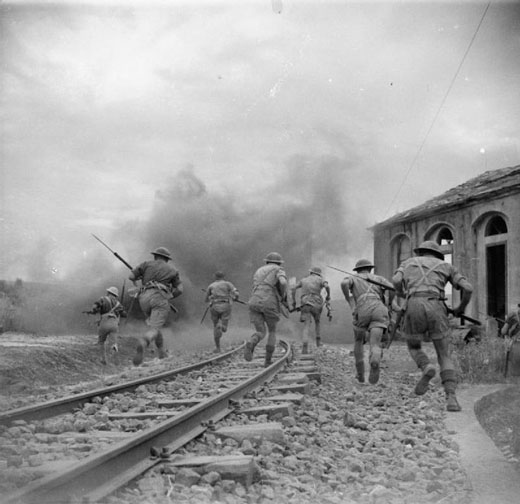 |
Italy, Politics
In the early hours of the morning the Fascist Grand Council passes a vote of no confidence in Mussolini. Mussolini is summoned to a meeting with the king in the afternoon and is told that he is being relieved of his offices. He is arrested on leaving the meeting. Marshal Badoglio is chosen to form the new government. The new government insists 'the war goes on'.
Mussolini Forced From Office |
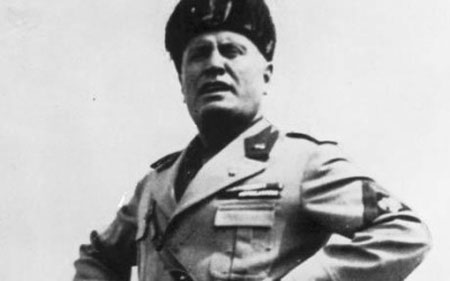 |
Hitler tells his generals: 'I shall send someone to Rome tomorrow with orders for the Commander of the 3rd Div to arrest everyone in the government, the king and the crown prince, and all that crew at once, and then Badoglio and his friends.'
[
|
|
New Georgia
The American offensive begins with units of the 25th Division supplementing the efforts of 43rd and 37th Divisions. Preceding the attack on Munda, 66 B-17s and B-24s bomb Lambeti plantation. Another strike of 84 aircrafte hits Bibilo hill. The attack bagins againse Japanese positions on Shimuzu hill, supported by tanks and flamethrowers. The 43rd Infantry Division's two regiments, the 103rd and the 172nd, move along the coast, while three regiments of the 37th Infantry Division (the 148th, 161st, and the 145th) attack the Japanese strongpoint from the front and flank. Supported by marine tanks, the infantrymen fight yard by yard into the midst of the well camouflaged, heavily fortified positions. The infantry attacks are supported by naval gunfire from seven destroyers. There is also another air strike with bombers dropping 145 tons of bombs on the enemy positions.
In spite of massive air and naval support little progress is made, however, except near a feature called Bartley Ridge. Other units on the right flank reach the coast near Terere.
[Pacific
The US submarine Pompon (SS-267) damages the Japanese transport Kinsen Maru and sinks the army cargo ship Thames Maru (5871t).
[Sicily
The Americans in the north are now meeting stronger resistance in their advance towards Messina. In the center the British and Canadians are attacking Agira from 2 directions where they are also meeting strong resistance. Allied reinforcements are being brought over to the island from North Africa including the US 9th and the British 78th Divs.
Maj-Gen Ridgway and Staff near Ribera, Sicily |
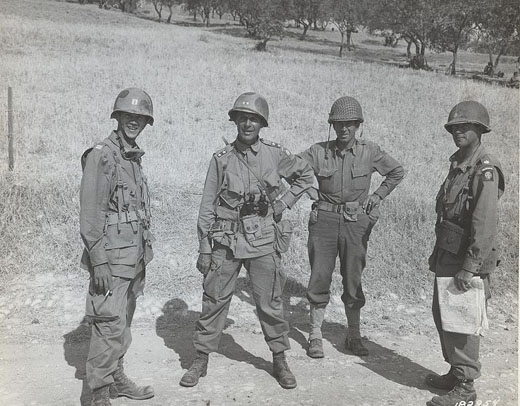 |
Solomons
Gen Nathan Twining replaces Rear-Adm Marc Mitscher in command of the air force in the Solomons, which now has 539 aircraft available and since June 30 has shot down 316 Japanese aircraft for the loss of only 71.
[United States, Home Front
The American destroyer escort Harmon is launched. It is the first US Navy ship ever named for a black. Leonard Roy Harmon, a mess attendant killed while saving a shipmate's life during the fight for Guadalcanal. He received the Navy Cross posthumously. The ship was christened by his mother.
[